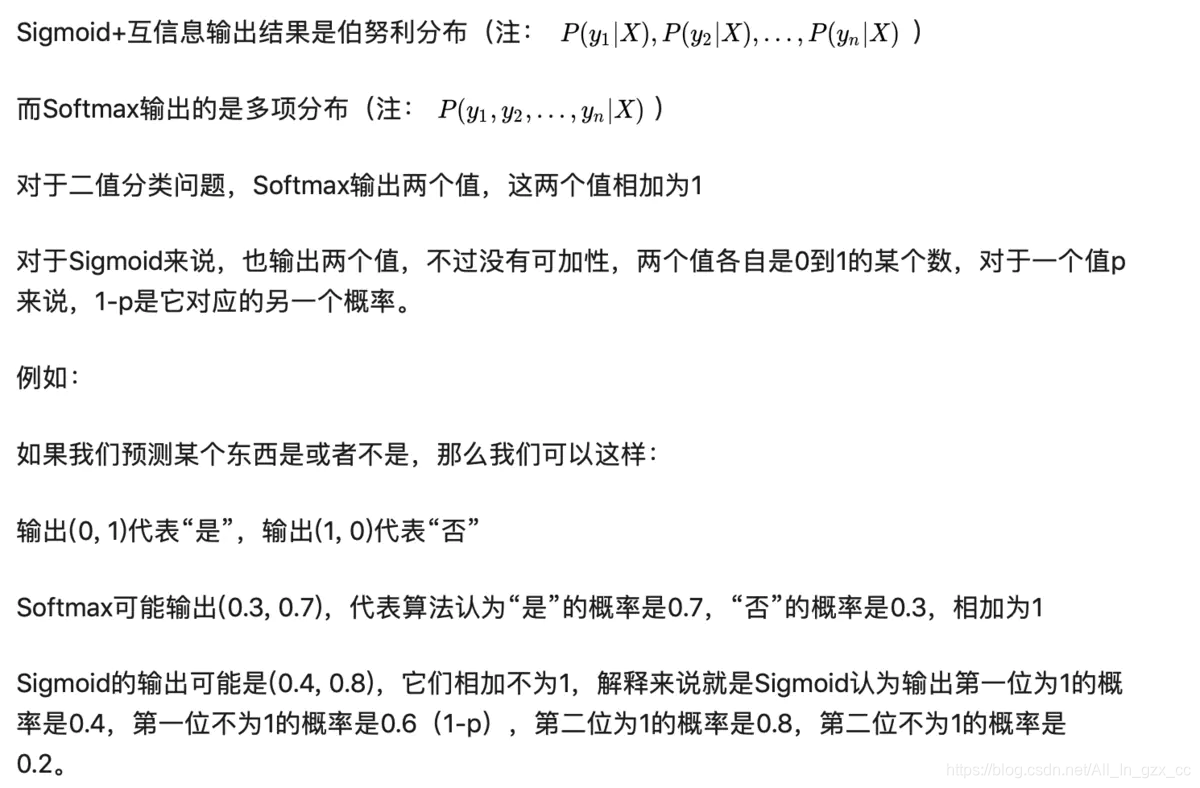多标签的问题的损失函数是什么
这里需要先了解一下softmax 与 sigmoid函数,因为sigmoid函数一般和BCELoss,BCEWithLogitsLoss一起使用。softmax和CrossEntropyLoss一起使用


Sigmoid函数针对两点分布提出。神经网络的输出经过它的转换,可以将数值压缩到(0,1)之间,得到的结果可以理解成分类成目标类别的概率P,而不分类到该类别的概率是(1 - P),这也是典型的两点分布的形式。Softmax函数本身针对多项分布提出,当类别数是2时,它退化为二项分布。而它和Sigmoid函数真正的区别就在——二项分布包含两个分类类别(姑且分别称为A和B),而两点分布其实是针对一个类别的概率分布,其对应的那个类别的分布直接由1-P得出。简单点理解就是,Sigmoid函数,我们可以当作成它是对一个类别的“建模”,将该类别建模完成,另一个相对的类别就直接通过1减去得到。而softmax函数,是对两个类别建模,同样的,得到两个类别的概率之和是1。
BCELoss
输入:([B,C], [B,C]),代表(prediction,target)的维度,其中,B是Batchsize,C为样本的class,即样本的类别数。
import torch
from torch import nn
input = torch.randn(3) # (3,1) 随机生成一个输入,没有被sigmoid。
print(input)
print(input.shape)
target=torch.Tensor([0., 1., 1.])
loss1=nn.BCELoss()
print("BCELoss:",loss1(torch.sigmoid(input), target))#需要sigmod
输出:
BCELoss: tensor(1.0053)
BCEWithLogitsLoss
输入:([B,C], [B,C]),输出:一个标量
import torch
from torch import nn
input = torch.randn(3) # (3,1) 随机生成一个输入,没有被sigmoid。
print(input)
print(input.shape)
target=torch.Tensor([0., 1., 1.])
loss2=nn.BCEWithLogitsLoss()
print("BCEWithLogitsLoss:",loss2(input,target))#不需要sigmoid
输出:
BCEWithLogitsLoss: tensor(1.0053)
CrossEntropyLoss
输入:([B,C], [B]) 输出:一个标量(这个minibatch的mean/sum的loss)
nn.CrossEntropyLoss计算过程:
- input: logits(未经过softmax的模型的"输出”)
- softmax(input)
- -log(softmax(input))
- 用target做选择提取(关于logsoftmax)· mean
等价于:nn.CrossEntropyLoss = nn.NLLLoss(nn.LogSoftmax)
import torch
from torch import nn
loss2 = nn.CrossEntropyLoss(reduction="none")
target2 = torch.tensor([0, 1, 2])
predict2 = torch.tensor([[0.9, 0.2, 0.8], [0.5, 0.2, 0.4], [0.4, 0.2, 0.9]])
print(predict2.shape) # torch.Size([3, 3])
print(target2.shape) # torch.Size([3])
print(loss2(predict2, target2))
# #结果计算为:
# tensor([0.8761, 1.2729, 0.7434])
举例
- BCEWithLogitsLoss计算ACC和Loss:
criterion = nn.BCEWithLogitsLoss()
# 计算准确率
def binary_accuracy(predicts, y):
rounded_predicts = torch.round(torch.sigmoid(predicts))
correct = (rounded_predicts == y).float()
accuracy = correct.sum() / len(correct)
return accuracy
# 训练
def train(model, iterator, optimizer, criterion):
model.train()
epoch_loss = 0
epoch_accuracy = 0
for batch in tqdm(iterator, desc=f'Epoch [{epoch + 1}/{EPOCHS}]', delay=0.1):
optimizer.zero_grad()
predictions = model(batch.text[0]).squeeze(1)
loss = criterion(predictions, batch.label)
accuracy = binary_accuracy(predictions, batch.label)
loss.backward()
optimizer.step()
epoch_loss += loss.item()
epoch_accuracy += accuracy.item()
return epoch_loss / len(iterator), epoch_accuracy / len(iterator)
- 计算ACC和Loss
# 截取情感分析部分代码
criterion = nn.CrossEntropyLoss()
total_loss = 0.0
correct_predictions = 0
total_predictions = 0
for batch in train_loader:
input_ids = batch['input_ids'].to(device)
labels = batch['label'].to(device)
optimizer.zero_grad()
logits = model(input_ids)
loss_sentiment = criterion(logits, labels.long())
loss_sentiment.backward()
optimizer.step()
total_loss += loss_sentiment.item()
# get sentiment accuracy
predicted_labels = torch.argmax(logits, dim=1)
correct_predictions += torch.sum(predicted_labels == labels).item()
total_predictions += labels.size(0)
accuracy = correct_predictions / total_predictions
loss = total_loss / len(train_loader)
总结
- 不管是二分类还是多分类,其实都可以只用CELOSS,只要target满足[0, 1, 2, …]
- BCELOSS和CELOSS的最大区别就是,BCE输出的是每个类的概率,而CE则约束了唯一类的概率。因此二/多分类可以无脑用CE,但是多标签更适合BCE



评论区